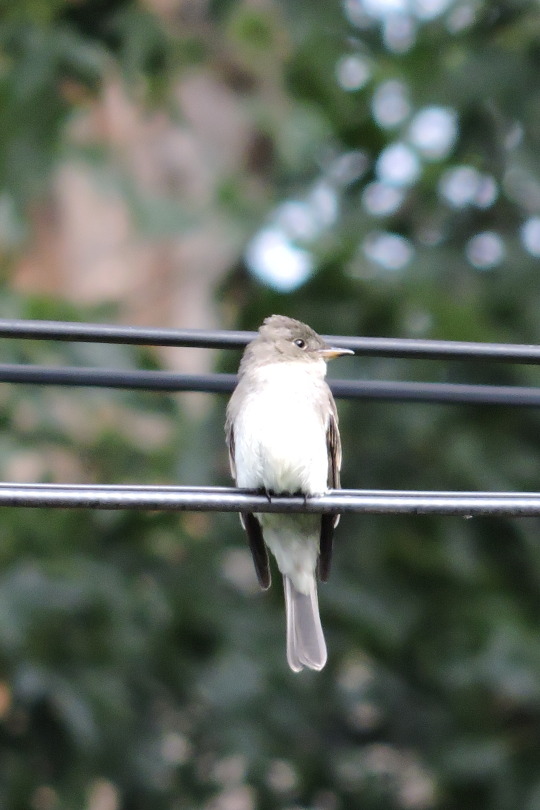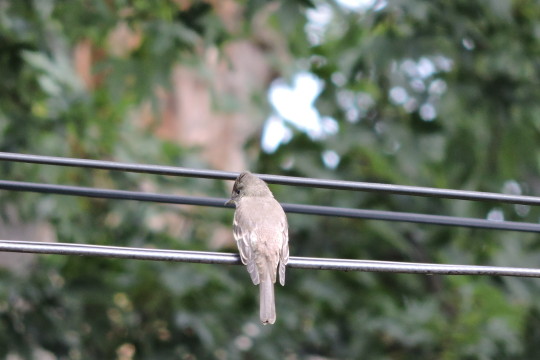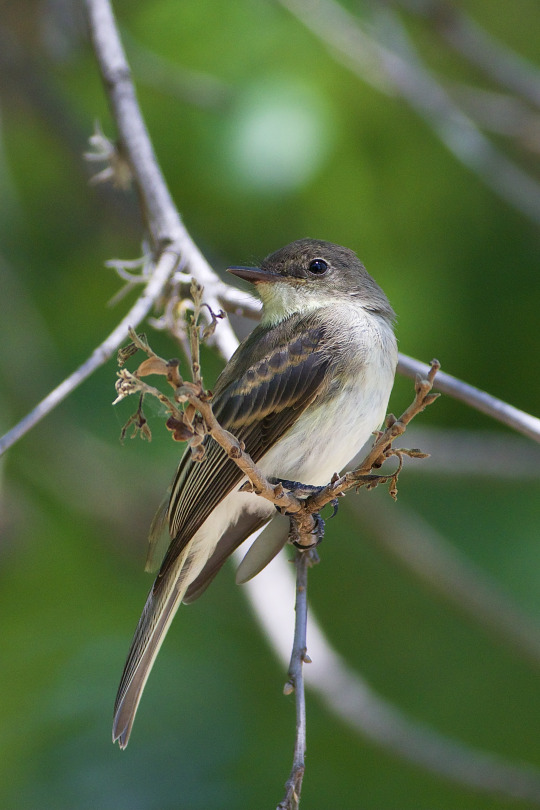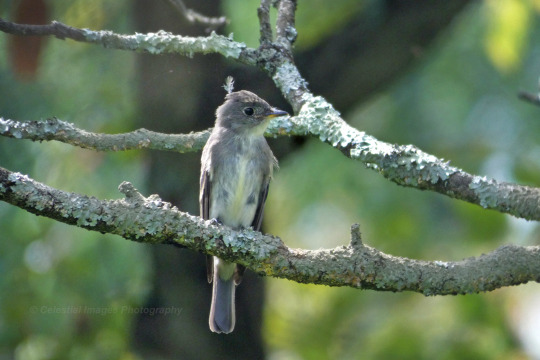#Contopus virens
Text
BOTD: Eastern Wood-Pewee

Photo: Andrew Cannizzaro
"In eastern woods in summer, the plaintive whistled pee-a-wee of this small flycatcher is often heard before the bird is seen. The bird itself is usually somewhere in the leafy middle story of the trees, perched on a bare twig, darting out to catch passing insects. The Wood-Pewee sings most often at dawn and dusk, and it may continue singing quite late in the evening, after most songbirds have fallen silent."
- Audubon Field Guide
#birds#eastern wood pewee#birds of north america#north american birds#flycatchers#pewees#wood pewees#tyrant flycatchers#passerines#birds of the us#birds of canada#birds of mexico#birds of central america#birds of the caribbean#birdblr#birblr#bird of the day#Contopus virens
28 notes
·
View notes
Text

EL PIBÍ DEL BOSQUE
A la sombra en el calor de la siesta
canta el pibí con su cadencia ligada
del verano estadizo y el otoño acedo.
Canta de la rama, va y viene flechado.
Y ya cante en septiembre, ya en julio,
canta al fin del verano, y se despide.
*
THE WOOD PEWEE
In the shade of a tree in the heat of afternoon
The wood pewee sings his portamento tune
That summer is over-ripe and autumn is soon.
He sings from a twdg after flitting to catch a fly.
And whether he sings September or July
He sings of the end of summer and sings goodby.
Robert Francis
di-versión©ochoislas
#Robert Francis#literatura estadounidense#poesía naturalista#verano#contopus virens#pibí del bosque#canto#despedida#di-versiones©ochoislas
3 notes
·
View notes
Text



Eastern Wood-Pewee, Contopus virens
4 notes
·
View notes
Photo

Eastern Wood-Pewee (Contopus virens), Garner State Park, Uvalde County, Texas.
47 notes
·
View notes
Photo

Eastern Wood-Pewee (Contopus virens) 06/11/2023 #peewee #bestbackroad #bestbackroads #natgeoyourshots #natgeo100contest #natgeo #rutlandcountyvt #washingtoncountyny #whitehallny #wildphotography #naturephotography #adventurephotography #wildlifephotography #roadphotography #nikon #photoadventure #naturetherapy #nationalgeographic #newengland #newyork #yorkmont #westhavenvt — view on Instagram https://ift.tt/mgKEdA4
0 notes
Text
.
“Contopus virens”
Papamoscas del este o Pibí oriental
.
.
.
.
.
.
.
.
.
.
#photography #photographer #photo #photoshoot #photoshop #photographylovers #photoshooting #bird #birds #birdphotography #birdsofinstagram #birds_captures #birdsofprey #birdwatching #birdlovers #birdingphotography ##cameraraw #canonphotography #canon #canon📷 #canonméxico #wildlife #wildlifephotography #wildlifephotographer #wildlifeonearth #wildlifeplanet #wildlifeconservation
instagram
0 notes
Photo

The little feather!
Eastern Wood-pewee (Contopus virens)
August 30, 2021
Southeastern Pennsylvania
#bird#birds#photographers on tumblr#eastern wood-pewee#birb#birbs#birblr#birdblr#ornithology#Contopus virens#birds of tumblr
296 notes
·
View notes
Photo

Eastern wood peewee at Ohio River Islands National Wildlife Refuge (via U.S. Fish and Wildlife Service Northeast Region)
Credit: Michael Schramm/USFWS
#Eastern Wood-Pewee#Contopus virens#Contopus#Tyrannidae#Tyrannides#Tyranni#Passeriformes#Psittacopasserae#Eufalconimorphae#Aves#birds#tyrant flycatcher#Ohio River Islands National Wildlife Refuge#Ohio River Islands NWR#Ohio River#West Virginia
8 notes
·
View notes
Photo

“I’m not a perch!”
Fledgling Eastern Wood-Pewee (Contopus virens) and Eastern Kingbird (Tyrannus tyrannus) were raised together after being orphaned because neither of them had other siblings of the same species to be raised with. Both birds belong to the family Tyrannidae, or “tyrant flycatchers,” which are known for their short flights collecting insects. The pewee had a habit of riding on the back of the kingbird (who didn’t seem to mind much).
2 notes
·
View notes
Photo

An Eastern Wood-Pewee (Contopus virens) kept returning to its favorite perch after venturing out after flying insects.
48 notes
·
View notes
Photo

. “Contopus virens” Papamoscas del este o Pibí oriental . . . . . . . . . . #photography #photographer #photo #photoshoot #photoshop #photographylovers #photoshooting #bird #birds #birdphotography #birdsofinstagram #birds_captures #birdsofprey #birdwatching #birdlovers #birdingphotography ##cameraraw #canonphotography #canon #canon📷 #canonméxico #wildlife #wildlifephotography #wildlifephotographer #wildlifeonearth #wildlifeplanet #wildlifeconservation https://www.instagram.com/p/CDhbjiEhMPs/?igshid=1s0l060kd2cyw
#photography#photographer#photo#photoshoot#photoshop#photographylovers#photoshooting#bird#birds#birdphotography#birdsofinstagram#birds_captures#birdsofprey#birdwatching#birdlovers#birdingphotography#cameraraw#canonphotography#canon#canon📷#canonméxico#wildlife#wildlifephotography#wildlifephotographer#wildlifeonearth#wildlifeplanet#wildlifeconservation
1 note
·
View note
Video
youtube
Eastern Phoebe I Believe? Can't say that I've studied wild birds that much, but these little guys keep me entertained. CLICK TO SUBSCRIBE - https://goo.gl/MFyIeQ Animal Facts publishes EVERY Monday and Friday, so click the notification bell to not miss a single fact. GET ANIMAL FACTS notifications in your Facebook Messenger Inbox - http://ift.tt/2s1YTmw HELP MAKE MORE VIDEOS LIKE THIS ONE! Become a Patron for as little as a dollar a month. http://ift.tt/2zblPE0 Our Official Website - http://ift.tt/2hJcgmZ You're here because you have a love for animals and want to know more about them. We're here because we love animals and want to know more about them and share that knowledge with you. If you love Animals, go ahead and subscribe, we publish on Mondays and Fridays. So, whether you're a dog lover, a cat fancier or have some less domestic critter in mind, let us know if you'd like us to cover an animal in a comment or in a message. We're all ears. The eastern phoebe (Sayornis phoebe) is a small passerine bird. The genus name Sayornis is constructed from the specific part of Charles Lucien Bonaparte's name for Say's phoebe, Muscicapa saya, and Ancient Greek ornis, "bird".[2] Phoebe is an alternative name for the Roman moon-goddess Diana, but it may also have been chosen to imitate the bird's call.[3] This tyrant flycatcher breeds in eastern North America, although its normal range does not include the southeastern coastal United States. It is migratory, wintering in the southernmost United States and Central America. It is a very rare vagrant to western Europe. This is one of the first birds to return to the breeding grounds in spring and one of the last to leave in the fall. They arrive for breeding in mid-late March, but they return to winter quarters around the same time when other migrant songbirds do, in September and early October; migration times have stayed the same in the last 100 years.[4][5] The increase in trees throughout the Great Plains during the past century due to fire suppression and tree planting facilitated a western range expansion of the eastern phoebe[6] as well as range expansions of many other species of birds.[7][8][9] This species appears remarkably big-headed, especially if it puffs up the small crest. Its plumage is gray-brown above. It has a white throat, dirty gray breast and buffish underparts which become whiter during the breeding season. Two indistinct buff bars are present on each wing. Its lack of an eye ring and wingbars, and its all dark bill distinguish it from other North American tyrant flycatchers, and it pumps its tail up and down like other phoebes when perching on a branch. The eastern phoebe's call is a sharp chip, and the song, from which it gets its name, is fee-bee. The eastern wood pewee (Contopus virens) is extremely similar in appearance. It lacks the buff hue usually present on the lighter parts of the eastern phoebe's plumage, and thus has always clearly defined and contrasting wing-bars. It also does not bob its tail habitually, and appears on the breeding grounds much later though it leaves for winter quarters at about the same time as the eastern phoebe.[5] The breeding habitat of the eastern phoebe is open woodland, farmland and suburbs, often near water. This phoebe is insectivorous, and often perches conspicuously when seeking food items. It also eats fruits and berries in cooler weather. It often nests on human structures such as bridges and buildings. Nesting activity may start as early as the first days of April.[4] The nest is an open cup with a mud base and lined with moss and grass, built in crevice in a rock or man-made site; two to six eggs are laid. Both parents feed the young and usually raise two broods per year. The eastern phoebe is occasionally host to the nest-parasitic brown-headed cowbird (Molothrus ater). by Animal Facts
0 notes
Photo

Eastern Wood-pewee (Contopus virens)
August 7, 2020
Southeastern Pennsylvania
#bird#birds#photographers on tumblr#Contopus virens#eastern wood-pewee#wood pewee#ornithology#birdblr#birblr#birds on tumblr
164 notes
·
View notes


